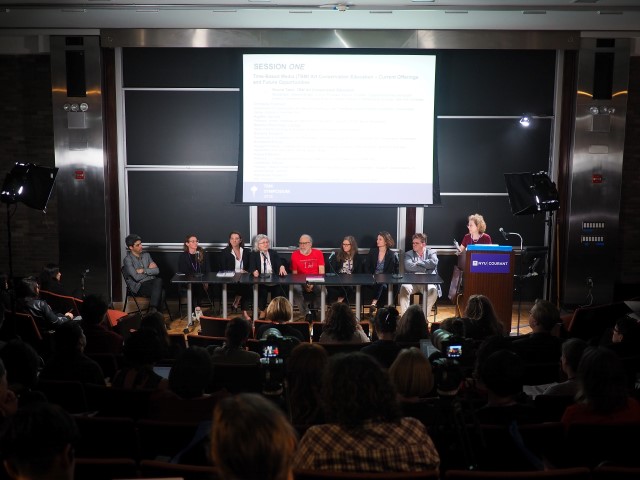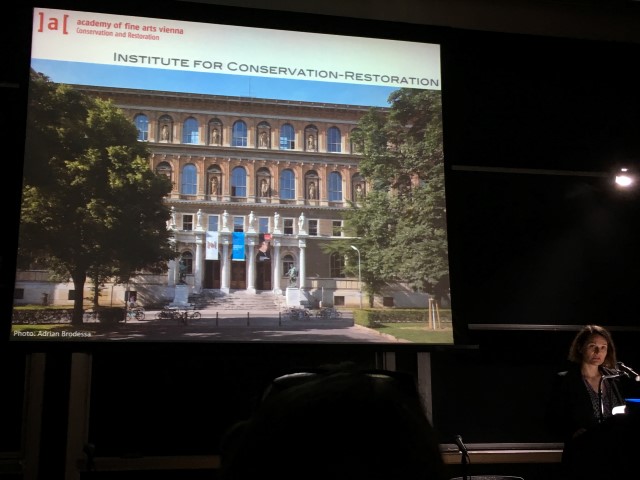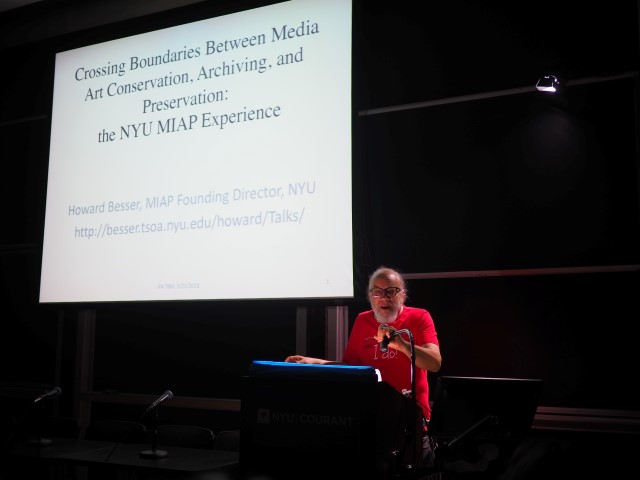This week’s contributing writer, Jillian Zhong, is a graduate student at ITP, NYU Tisch and an alumni of NYU Courant. She has worked previously on software-based art conservation projects at the Guggenheim Museum while a computer science student at Courant as well as after graduating.
VoCA is pleased to present this blog post in conjunction with the NYU/IFA Conservation Center’s Symposium “It’s About Time! Building a New Discipline: Time-Based Media Art Conservation,” held at NYU in May 2018. The program was organized by Hannelore Roemich and Christine Frohnert and was generously supported by the Andrew W. Mellon Foundation.
The first session of the TBM Symposium 2018 focused on the current state of time-based media art conservation education at various universities internationally. Each speaker, representing an academic institution or department, outlined their current program structure and highlighted various challenges they have experienced. Introductory speaker Christine Frohnert, Conservator of Contemporary Art at Bek & Frohnert LLC and Time-Based Media Program Coordinator at the Institute of Fine Arts, New York University, provided an overview of the development of the TBM specialty. She emphasized the importance of collectively establishing a TBM discipline by identifying education needs and by providing appropriate specialized training. Through this session of talks and the following round table discussion, a wide range of experiences and approaches were shared.
Agathe Jarczyk, Professor at the University of Arts at Berne, described the Modern Materials and Media Art Conservation program, which has offered advanced and rigorous Time-Based Media conservation education since 1999. In order to reflect the demands in the European museums positions, the program also provides a broader education in contemporary art conservation to prepare students to handle many materials including Time-Based Media. This goal is translated into their program structure, with students working with the primary staff of conservators and art historians as well as industry professionals. Jarczyk reiterated the aim of having students come away with not only the appropriate skill set for TBM conservation, but also the appropriate mindset.
Martina Pfenninger Lepage, Head of Studio/Teaching & Research at Academy of Fine Arts Vienna also highlighted the importance of working with specialists, stating it as a priority for students. Students also work on case studies in the field, part of the program’s goals of enhancing connections with professionals and raising awareness in the larger conservation field.
Evelyne Snijders, Conservator, Post-Master Coordinator, Lecturer at University of Amsterdam, like Jarczyk, stressed the importance of students developing a decision making process for contemporary art conservation — the program provides hands-on training starting from the first year. The program already offers TBM workshops where students work on selected case studies. Snijders and her colleagues aim to further embed TBM conservation into the context of contemporary art and provide further TBM course offerings.
Humberto Farias, Assistant Professor at the School of Fine Arts, Federal University of Rio de Janeiro, attested to the benefits of enhanced connections and collaboration; the contemporary art conservation program offered its first course in TBM conservation in 2016 after he attended a workshop at NYU. Students are introduced to TBM conservation under the umbrella of contemporary art conservation and collaborate with the Niterói Contemporary Art Museum. More resources are required to establish a rigorous TBM education program in Brazil.
Howard Besser, Professor and Co-Associate Director at Moving Image Archiving and Preservation (MIAP), New York University, noted that the MIAP program included both, strengths in theory and practice. Although the program focuses on students learning skills tailored for archiving audio/visual media, a large number of students enter the conservation field through internships and work experience.
Johannes Gfeller, Professor and Head of Master’s Program at Stuttgart State Academy of Art and Design, highlighted his students’ opportunities to gain experience in the field through external internships. Gfeller wants the program to address concerns about disappearing knowledge of aging analog technology, especially in Germany where “media conservation” is not a common term.
Hannelore Roemich, PhD, Professor at the Institute of Fine Arts, New York University introduced TBM conservation as a new specialization at the Conservation Center of the Institute of Fine Arts (IFA), NYU, starting in fall 2018. The newly developed TBM program benefits from collaboration with other departments within NYU as well as with institutions within New York City and beyond, placing students in internships and engaging guest lecturers. The IFA will offer workshops on TBM art conservation that are open to externals, an opportunity to further professional development for those who work already in the field.

The round table discussion included every speaker from this session and was moderated by Deena Engel, Clinical Professor and Program Director of the Digital Humanities and Social Science Program at New York University. The panelists discussed the challenges that their programs face, the differences between TBM conservation programs and traditional conservation programs, and how traditional conservation ethics are being taught in a TBM context. When a participant in the audience raised the topic of demographics and diversity in the TBM conservation field, Margaret Holben Ellis, Chair and Eugene Thaw Professor of Paper Conservation at Institute of Fine Arts, New York University, in the audience, added her perspective that diversity could increase if awareness of TBM is raised in communities other than the fine arts, such as engineering or the library archives field.
Session One provided a survey of TBM conservation education at universities across Europe and the Americas. Even though these institutions vary in size, age, and resources, all highlighted the evolution of their educational programs and identified similar challenges and goals for the future.
The full program and video of this session can be found at https://www.nyu.edu/gsas/dept/fineart/events/tbmsymposium2018.htm



